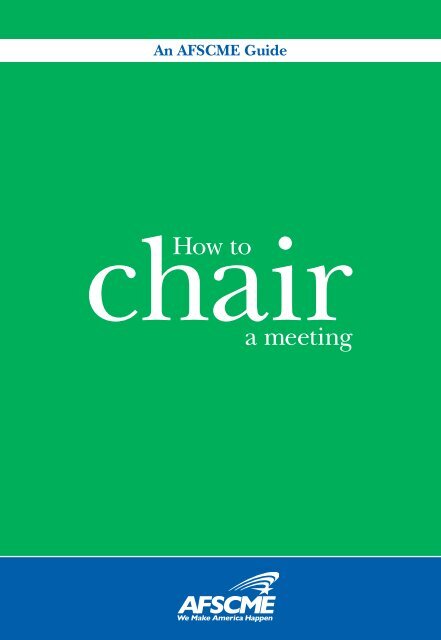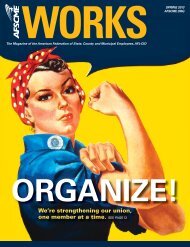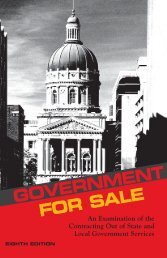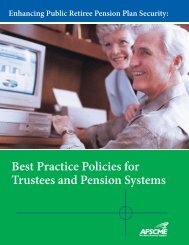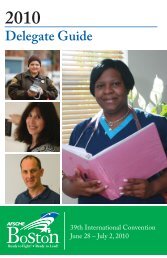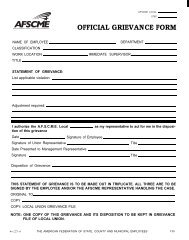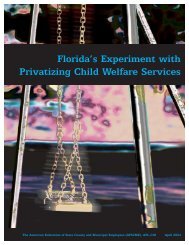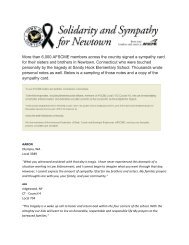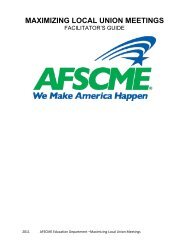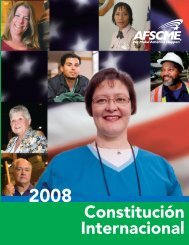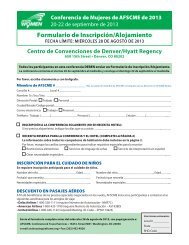How to Chair a Meeting - AFSCME
How to Chair a Meeting - AFSCME
How to Chair a Meeting - AFSCME
You also want an ePaper? Increase the reach of your titles
YUMPU automatically turns print PDFs into web optimized ePapers that Google loves.
An <strong>AFSCME</strong> Guide<br />
chair<br />
<strong>How</strong> <strong>to</strong><br />
a meeting
Page<br />
1<br />
1 Call <strong>to</strong> Order<br />
Start Your <strong>Meeting</strong> on Time.<br />
Rap your gavel and say: “I call this meeting <strong>to</strong> order.” Wait for quiet, and then<br />
begin the meeting.<br />
1 Call <strong>to</strong> Order
Page<br />
2<br />
2 Roll Call of Officers<br />
The <strong>Chair</strong> says: “The Recording Secretary will call the Roll of Officers.”<br />
The Recording Secretary then calls the roll in a loud, clear voice, with pauses<br />
for response.<br />
3 Reading of Minutes<br />
The <strong>Chair</strong> says: “The Secretary will read minutes of the last meeting.” Alternatively,<br />
copies of the minutes can be distributed at the meeting and the <strong>Chair</strong> says: “Instead<br />
of having the Secretary read the minutes, copies have been distributed for your<br />
review.”<br />
After the minutes are read or reviewed, the <strong>Chair</strong> asks: “Are there any additions or<br />
corrections <strong>to</strong> the minutes? [Pause.] If not, the minutes will stand approved as<br />
read.” If corrections <strong>to</strong> the minutes are made, ask for unanimous consent <strong>to</strong> additions<br />
or corrections at this time. If there is an objection <strong>to</strong> any addition or correction, it will<br />
be necessary <strong>to</strong> adopt a motion <strong>to</strong> make that change.<br />
2 Roll Call of Officers 3 Reading of Minutes
4 Reading of Correspondence<br />
Page<br />
3<br />
The <strong>Chair</strong> says: “The Recording Secretary will now read the correspondence.”<br />
The Recording Secretary should then read any important correspondence, summarizing the<br />
content when appropriate.<br />
Any letter requiring action by the membership should be discussed by the Executive Board<br />
prior <strong>to</strong> the membership meeting. At the membership meeting, the letter should be read along<br />
with the recommendations of the board. A motion should be made <strong>to</strong> adopt the board’s<br />
recommended action. That motion should then be discussed and voted on by the members.<br />
Routine letters should not be taken up at the membership meeting.<br />
4 Reading of Correspondence
Page<br />
4<br />
5 Reports of Officers<br />
The President’s Report might include such <strong>to</strong>pics as:<br />
• Problems facing the local • Updates on issues affecting the members<br />
• Summary of <strong>to</strong>pics discussed at the • Actions the Executive Board<br />
latest Executive Board meeting recommends that the local take<br />
If the President’s Report contains any actions recommended by the Executive<br />
Board, a motion should be made <strong>to</strong> adopt the board’s recommended action. That<br />
motion is then discussed and voted on by the members. To initiate discussion,<br />
the <strong>Chair</strong> may say something like: “Does the <strong>Chair</strong> hear a motion <strong>to</strong> accept the<br />
Executive Board’s recommendation?”<br />
Secretary-Treasurer’s Report: This report should be copied and passed out at the<br />
meeting. See a sample report in the <strong>AFSCME</strong> Officers Handbook, Appendix A, or in<br />
material following Appendix E of the <strong>AFSCME</strong> International Constitution.<br />
The <strong>Chair</strong> asks: “Does everyone have a copy of the Secretary-Treasurer’s<br />
Report? [Pause.] Are there any questions? [Pause.] If there are no objections,<br />
the Secretary-Treasurer’s Report will stand approved.”<br />
If someone raises an objection, a motion of approval is required.<br />
5 Reports of Officers
Page<br />
5<br />
6 Reports of Staff and Committees<br />
Staff Report:<br />
This may include the latest information on political and legislative issues, organizing<br />
campaigns, important grievances, council activities, an update on contract negotiations,<br />
or any other information of current interest <strong>to</strong> the membership.<br />
Committee Reports:<br />
Before the membership meeting, the President should talk with each committee<br />
chairperson and go over his/her Committee Report. Reports from any given committee<br />
should be made only when there is something worthwhile <strong>to</strong> report.<br />
To introduce these reports, the <strong>Chair</strong> would say:<br />
“We will now hear a report from the ____________________<br />
Committee.”<br />
If a committee report contains specific recommendations, which call for membership<br />
action, then after the report is given the <strong>Chair</strong> would say:<br />
“You have heard the report of the ________________________ Committee,<br />
with the recommendation that the membership authorize _____________.<br />
Does the <strong>Chair</strong> hear a motion <strong>to</strong> adopt the ____________________<br />
Committee’s recommendation?”<br />
6 Reports of Staff and Committees
Page<br />
6<br />
Offering an Amendment<br />
7 Unfinished Business<br />
Unfinished Business: Includes any items that require membership action that are<br />
left over, or postponed, from a previous meeting.<br />
The <strong>Chair</strong> would say something like:<br />
“We have some old, unfinished business <strong>to</strong> take care of.”<br />
The <strong>Chair</strong> can then review the <strong>to</strong>pic. This may be followed by a motion dealing with<br />
the specific item of unfinished business.<br />
8 New Business<br />
New Business: Includes items raised at this meeting, which were not necessarily<br />
included on the agenda, and which require membership action. This is the membership’s<br />
chance <strong>to</strong> raise issues that are not included on the agenda.<br />
To open this part of the meeting, the <strong>Chair</strong> would say:<br />
“Is there any new business?”<br />
For the group <strong>to</strong> make a decision on any new business brought up at a meeting,<br />
remember what is required: a motion, a second, a chance for discussion and a vote.<br />
7 Unfinished Business 8 New Business
Page<br />
7<br />
9 Good and Welfare<br />
Good and Welfare: A local may have a Good and Welfare Committee. If it does not,<br />
this part of the meeting can be used <strong>to</strong> discuss such things as sending cards or flowers<br />
<strong>to</strong> hospitalized members, soliciting donations for community food banks, announcing<br />
happy events like marriages and births, etc. It may also be used for some planned activity,<br />
such as a visiting speaker or training. Consider moving this item earlier in the agenda if<br />
such an activity is planned.<br />
The <strong>Chair</strong> asks: “Is there any Good and Welfare?”<br />
10 Adjournment<br />
Adjourning the <strong>Meeting</strong>: When the business of the meeting is finished, and if no<br />
one has made a motion <strong>to</strong> adjourn, the <strong>Chair</strong> should ask for one by saying:<br />
“Do I hear a motion <strong>to</strong> adjourn?”<br />
A motion <strong>to</strong> adjourn must be seconded, and is then voted on without debate.<br />
9 Good and Welfare 10 Adjournment
Page<br />
8<br />
Some Additional Notes for the <strong>Chair</strong>person<br />
• The <strong>Chair</strong> should make sure that all reports given at the meeting are brief and <strong>to</strong> the<br />
point. This will help keep the whole meeting short. People are more likely <strong>to</strong> attend<br />
meetings that are run efficiently and end on time!<br />
• When a motion is made it must be seconded. The <strong>Chair</strong> should then state the<br />
motion and call for discussion: “It has been moved and seconded that ...<br />
Is there any discussion?”<br />
• Sometimes an amendment <strong>to</strong> the motion on the floor may be offered. An amendment<br />
must be seconded and then discussed. The <strong>Chair</strong> should say: “An amendment has<br />
been made and seconded that ... Is there any discussion on the amendment?”<br />
A vote is first taken on the amendment. After the amendment is decided on, the<br />
discussion returns <strong>to</strong> the main motion (as amended if the amendment was passed).<br />
A vote is then taken on the main motion.<br />
• During a discussion of a motion or amendment, make sure that each member speaks<br />
only once until all other members have had an opportunity <strong>to</strong> speak. It is a good idea<br />
<strong>to</strong> alternate speakers for and against the motion. If members begin responding <strong>to</strong> and<br />
addressing remarks <strong>to</strong> each other, remind the group that all comments should be<br />
addressed <strong>to</strong> the <strong>Chair</strong>. The discussion and debate is for the group as a whole <strong>to</strong><br />
participate in. It is not an argument between a couple of<br />
members.<br />
• A member may raise a “Point of Information.” For instance, he or she might state:<br />
“Point of Information. I don’t understand the intent of this motion.” The <strong>Chair</strong><br />
should then clarify the intent of the motion or provide the information being requested.<br />
You may have <strong>to</strong> remind the member that a point of information is a question, not a<br />
statement.<br />
• Sometimes a member may rise on a “Point of Order,” saying something like: “Point<br />
of Order. This discussion does not pertain <strong>to</strong> the motion on the floor.” The <strong>Chair</strong><br />
should make a ruling and say something like: “Your point is well taken and I direct<br />
the member speaking <strong>to</strong> address the motion on the floor.”<br />
• There are times when discussion on a <strong>to</strong>pic begins but no motion has been made. In this<br />
instance, the <strong>Chair</strong> may call for a motion by saying, “Does the <strong>Chair</strong> hear a motion <strong>to</strong><br />
...?” Of course, this motion must be seconded and the <strong>Chair</strong> should re-state the motion<br />
before asking if there is discussion.<br />
For a chart on Key Parliamentary Rules, see Appendix E of the <strong>AFSCME</strong> International Constitution.<br />
For a detailed description of “Robert’s Rules of Order,” see Parliamentary Procedure at a Glance by O. Garfield Jones. This can be<br />
ordered from: <strong>AFSCME</strong> F2 Orders, 1625 L Street, N.W., Washing<strong>to</strong>n, D.C. 20036-5687.<br />
Some Additional Notes for the <strong>Chair</strong>person
Robert’s Rules of Order<br />
Chart of Motions & Procedures<br />
These motions are listed in order of precedence. A motion can be introduced if it is<br />
higher on the chart than the pending motion.<br />
Purpose You Say Can<br />
Interrupt<br />
Close the<br />
meeting<br />
Register a<br />
complaint<br />
Lay the<br />
motion<br />
aside<br />
temporarily<br />
End<br />
debate<br />
Limit or<br />
extend<br />
debate<br />
Postpone<br />
<strong>to</strong> a<br />
certain time<br />
Refer <strong>to</strong> a<br />
committee<br />
Modify the<br />
wording of<br />
the motion<br />
Postpone<br />
the decision<br />
indefinitely<br />
I move <strong>to</strong><br />
adjourn<br />
I rise <strong>to</strong> a<br />
question of<br />
privilege<br />
I move <strong>to</strong><br />
table the<br />
motion<br />
I call the<br />
question;<br />
OR I move<br />
<strong>to</strong> end<br />
debate<br />
I move that<br />
debate be<br />
limited <strong>to</strong>…<br />
I move <strong>to</strong><br />
postpone<br />
the motion<br />
<strong>to</strong>…<br />
I move <strong>to</strong><br />
refer the<br />
motion <strong>to</strong>…<br />
I move <strong>to</strong><br />
amend the<br />
motion by…<br />
I move<br />
that the<br />
motion be<br />
postponed<br />
indefinitely<br />
Requires<br />
a Second<br />
Debatable Can be<br />
Amended<br />
Vote<br />
Required<br />
No Yes No No Majority<br />
Yes No No No None<br />
No Yes No No Majority<br />
No Yes No No 2/3<br />
No Yes No Yes 2/3<br />
No Yes Yes Yes Majority<br />
No Yes Yes Yes Majority<br />
No Yes Yes Yes Majority<br />
No Yes Yes No Majority
No order of precedence. These motions arise incidentally and are decided immediately.<br />
Page<br />
9<br />
Purpose You Say Can<br />
Interrupt<br />
Enforce the<br />
rules<br />
Submit the<br />
matter <strong>to</strong><br />
the group<br />
Suspend the<br />
rules<br />
Divide the<br />
motion<br />
Demand<br />
rising vote<br />
Ask a<br />
question<br />
about parliamentary<br />
procedure<br />
Request for<br />
information<br />
Point of<br />
order<br />
I appeal the<br />
decision of<br />
the <strong>Chair</strong><br />
I move <strong>to</strong><br />
suspend the<br />
rules<br />
I move <strong>to</strong><br />
divide the<br />
question<br />
I call for a<br />
division<br />
Parliamentary<br />
inquiry<br />
Point of<br />
information<br />
Requires<br />
a Second<br />
Robert’s Rules of Order<br />
Debatable Can be<br />
Amended<br />
Yes No No No None<br />
Vote<br />
Required<br />
Yes Yes Varies No Majority<br />
No Yes No No 2/3<br />
No Yes No Yes Majority<br />
Yes No No No None<br />
Yes No No No None<br />
Yes No No No None<br />
No order of precedence. Introduce only when nothing else is pending before the group.<br />
Purpose You Say Can<br />
Interrupt<br />
Take the<br />
matter from<br />
the table<br />
Cancel a<br />
previous<br />
action<br />
Reconsider<br />
a motion*<br />
I move <strong>to</strong><br />
take from<br />
the table<br />
I move <strong>to</strong><br />
rescind<br />
I move <strong>to</strong><br />
reconsider<br />
the vote<br />
Requires<br />
a Second<br />
Debatable Can be<br />
Amended<br />
Vote<br />
Required<br />
No Yes No No Majority<br />
No Yes Yes Yes 2/3; or<br />
Majority<br />
with<br />
notice<br />
No Yes Yes, if<br />
motion it<br />
applies <strong>to</strong> is<br />
debatable<br />
No Majority<br />
* can be made only by someone who voted for the prevailing side in the previous vote on the motion
American Federation of State, County<br />
and Municipal Employees, AFL-CIO<br />
1625 L Street, NW • Washing<strong>to</strong>n, DC 20036<br />
afscme.org<br />
Gerald W. McEntee<br />
International President<br />
Lee A. Saunders<br />
International Secretary-Treasurer<br />
455-10


